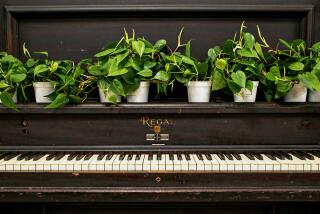An Ear for Music : Students of Suzuki Method Learn to Play by Listening
- Share via
Back in the 1930s, Dr. Shinichi Suzuki had an idea. Students could learn music, he suggested, just the way children learn to speak, by listening and imitating those around them.
Today, his method is known around the world, and children barely old enough to steer tricycles work with pint-sized violins to make some beautiful music.
The main goal of Suzuki is “to educate and enrich the lives of every child through music,” said Idell Low, director of the Van Nuys branch of the Suzuki Music Program of Los Angeles. Often, she said, this education “starts in the womb. Learning music is a long process.”
Robin Johnson of La Crescenta has two daughters learning the Suzuki Method from Low, and 3-year-old Camille will join her sisters in September.
These days Camille clutches at her fiddle box--a contact paper-covered box of macaroni and cheese with a stick glued to it--and mimics her two older sisters, who play everything from Bach minuets to concertos by contemporary composer Paul Seitz.
The oldest Johnson daughter, 8-year-old Rachel, joined the Suzuki program when she was 5. Chelsea, 7, started at 4. After Johnson asked a friend for advice on a reputable school, she was told that “students who study the Suzuki Method are heads and shoulders above the rest” by the time they reach junior high.
“I look at music the same way I look at the food triangle,” Johnson said of her family’s musical tastes. She said the family prefers “a pinch of rock at the top with a very thick base of classical music.”
One Suzuki alumna is Aurelia D’Antonio, 15, who will be a student at El Camino Real High School in Woodland Hills this fall. She learned the glories of Bach and Vivaldi but, like any teenager, appreciates more modern sounds too. “I like to listen to KROQ,” she said.
More to Read
The biggest entertainment stories
Get our big stories about Hollywood, film, television, music, arts, culture and more right in your inbox as soon as they publish.
You may occasionally receive promotional content from the Los Angeles Times.










